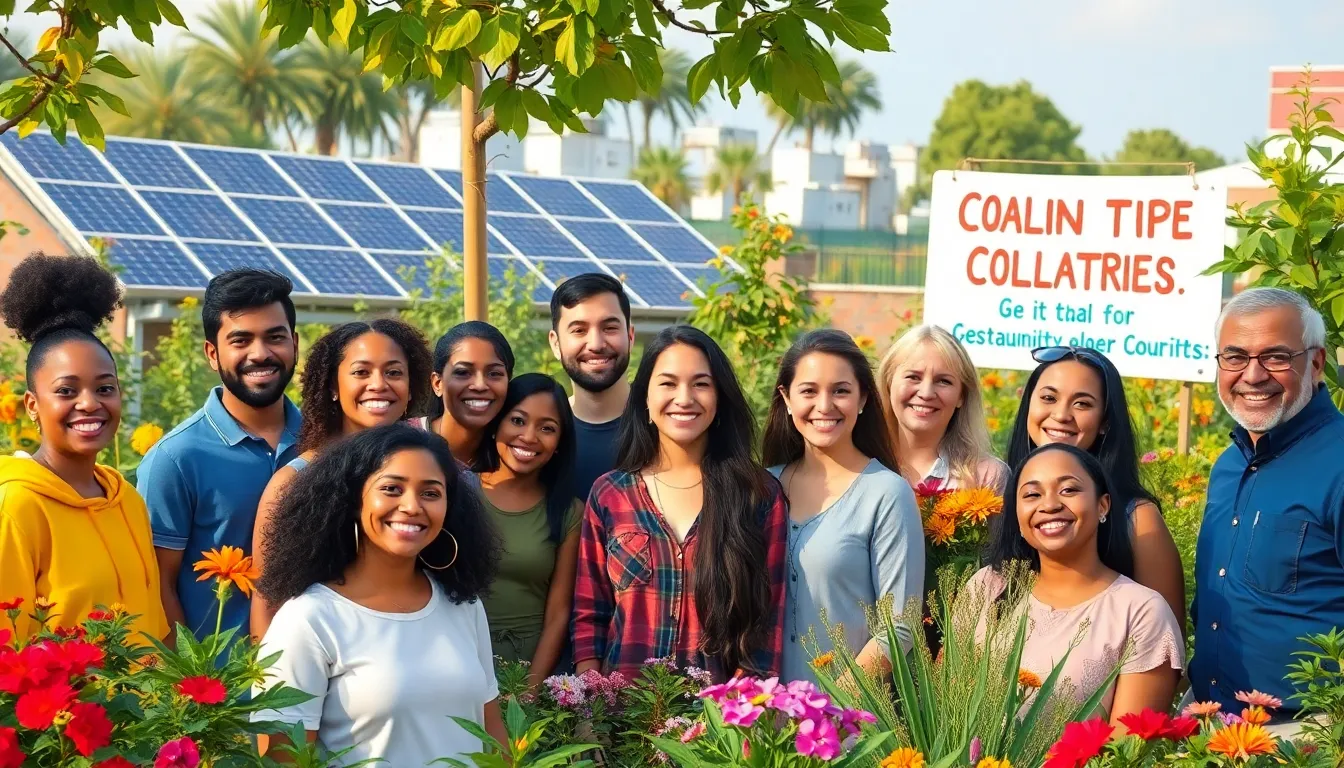Table of Contents
ToggleIn a world where “sustainable” is the new black, creating a sustainable community isn’t just a trend; it’s a necessity. Imagine a neighborhood where the air smells fresh, the gardens are bursting with veggies, and the only thing that goes to waste is that old pizza in the fridge. Sounds dreamy, right? Well, it’s not just a pipe dream—it’s happening right now in communities that prioritize sustainability.
Building a sustainable community means more than just recycling your coffee cups and hugging trees. It’s about fostering connections, reducing carbon footprints, and creating a vibrant, eco-friendly lifestyle that everyone can enjoy. So buckle up and get ready to explore how these communities are paving the way for a greener future, one compost bin at a time. Who knew saving the planet could be this much fun?
Understanding Sustainable Communities
Sustainable communities prioritize environmental health and social well-being. These neighborhoods leverage resources effectively, fostering long-term resilience.
Definition and Key Characteristics
Sustainable communities focus on minimizing environmental impact. Characteristics include energy-efficient buildings, green spaces, and accessible public transport. Recreational areas enhance social interactions while promoting physical activity. Communities often employ renewable energy sources, reducing reliance on fossil fuels. Local food production through community gardens supports healthier diets. Effective waste management systems contribute to lower pollution levels. Each feature enhances the quality of life while protecting natural resources.
Importance in Modern Society
Modern society faces numerous challenges like climate change and urbanization. Sustainable communities address these issues effectively. They reduce carbon footprints, promoting eco-friendly practices. Resilient neighborhoods foster economic growth by creating green jobs. These communities cultivate a sense of belonging through strengthened social ties. Engaging in sustainability leads to healthier lifestyles, improving community well-being. Innovations in sustainable living inspire global efforts toward responsible resource management.
Elements of a Sustainable Community

Sustainable communities incorporate various elements that create a balanced, thriving environment. These aspects not only enhance residents’ quality of life but also contribute to the planet’s well-being.
Environmental Stewardship
Environmental stewardship forms the backbone of a sustainable community. Communities prioritize conservation practices, promoting biodiversity and ecosystem health. Urban gardens and green roofs help offset carbon emissions and enhance occupant well-being. Effective waste management reduces landfill impact and encourages recycling. Renewable energy initiatives, such as solar panels and wind turbines, supply clean energy, minimizing dependency on fossil fuels. Implementing these strategies fosters a culture of appreciation for natural resources, leading to healthier environments for future generations.
Economic Viability
Economic viability supports the sustainability of communities by fostering local economies. Sustainable practices often lead to green job creation, enhancing residents’ income opportunities. Investing in public transport elevates accessibility, allowing for greater economic participation. Collaborating with local businesses strengthens the community’s supply chains while reducing carbon emissions in shipping. Programs that focus on sustainable agriculture ensure food security while promoting local food sources. Communities that thrive economically demonstrate resilience against financial downturns, ensuring long-term sustainability for residents.
Social Equity
Social equity ensures all community members benefit from sustainability efforts. Providing equal access to resources like affordable housing and public amenities fosters inclusivity. Strong social networks empower residents to engage in decision-making processes, promoting a sense of belonging. Educational initiatives raise awareness of sustainability issues, equipping individuals with essential knowledge. Enhanced public spaces encourage social interaction, building trust among neighbors. Through these measures, communities cultivate an environment where every resident’s voice matters, contributing to collective well-being.
Successful Examples of Sustainable Communities
Sustainable communities are emerging worldwide, showcasing innovative approaches to environmental, economic, and social challenges.
Case Study: Eco-Villages
Eco-villages serve as prime examples of sustainable living practices. They integrate renewable energy sources like solar power and wind energy to minimize carbon footprints. Residents often engage in permaculture and organic farming, enhancing food security and biodiversity. Such villages foster a sense of community through shared resources, cooperative decision-making, and cultural activities. For instance, the Findhorn Foundation in Scotland exemplifies collective sustainability, highlighting communal living and environmental education.
Case Study: Urban Regenerative Initiatives
Urban regenerative initiatives transform cityscapes into vibrant, eco-friendly spaces. Programs focus on revitalizing neglected areas by incorporating green roofs, urban gardens, and native plant landscaping. These initiatives promote biodiversity while improving air quality and reducing heat islands. The High Line in New York City illustrates how repurposing infrastructure can create green public spaces that enhance community well-being. Additional examples include the Bosco Verticale in Milan, where residential towers integrate vertical gardens, contributing to urban greening and energy efficiency.
Challenges in Building Sustainable Communities
Building sustainable communities presents unique challenges that must be addressed. These hurdles can hinder progress and limit the potential for greener living.
Resistance to Change
Resistance to change often stems from ingrained habits and traditional views. Many individuals feel secure in existing lifestyles that prioritize convenience over sustainability. Convincing these residents to adopt new practices requires community outreach and education initiatives. Engaging local leaders to champion sustainability efforts can stimulate interest and participation. Moreover, providing clear benefits of sustainability, such as cost savings and improved quality of life, can gradually shift perceptions.
Funding and Resources
Securing funding and resources remains a significant challenge for sustainable community projects. Limited financial support restricts the implementation of innovative initiatives. Diverse funding sources, including government grants and private investments, are essential for success. Developing partnerships with local businesses enhances resource availability and generates community investment. Furthermore, establishing detailed budgets and transparent plans can attract stakeholders committed to sustainable development.
Sustainable communities represent a vital shift toward a healthier and more resilient future. By prioritizing environmental stewardship and social equity, they create spaces where individuals can thrive while protecting natural resources. The innovative practices and successful case studies illustrate that these communities not only enhance quality of life but also foster a sense of belonging among residents.
As more people recognize the benefits of sustainable living, the movement continues to grow. Overcoming challenges like resistance to change and securing funding will be essential for further development. Ultimately, the journey toward sustainable communities is a collective effort that promises a brighter future for all.




